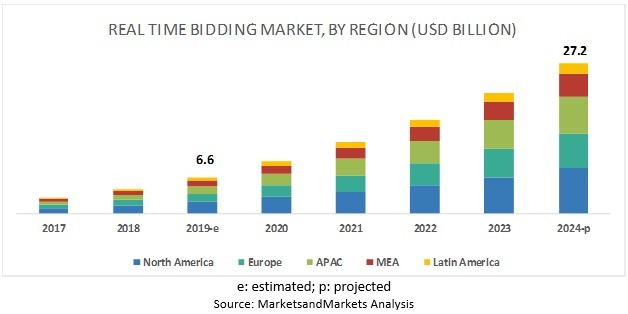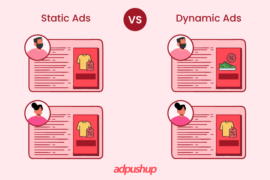Real-Time Bidding is a type of programmatic buying where impressions are sold in a real-time auction. Here’s all about Real Time Bidding (RTB).
What Is RTB? (Explained in Detail)
Real Time Bidding (RTB) is a revolutionary method of digital advertising that allows advertisers to bid on and display ads to internet users in real-time.
In fact, the RTB market is experiencing significant growth due to the increased adoption of full cycle software development, website design, artificial intelligence (AI), and machine learning (ML).
If you are asking why the concise answer will be that RTB allows increased control of the publishers in the way they manage their advertisement inventory – it also includes the fact that they can fix price floors here, which provides quite a bit of leverage.
Therefore, publishers ought to look for and pick real time bidding, which will give them better opportunities for monetization so that they can achieve optimum campaign performance.

Also Read: Publishers Must Know These Real-Time Bidding Best Practices (2023)
Definition of Real Time Bidding – How It Works?

Real-time bidding is a process of valuing and bidding for an ad impression in real-time. It is an online media marketplace involving the seller (publisher) and buyer (advertiser).
RTB offers a lot of capabilities and use of data and vast types of inventory. It is universally considered the most flexible model on the market.
Take the stock market as an analogy to understand real-time bidding. In the stock market, when a share becomes available, buyers have to compete for it, and the highest bidder gets the share.
Likewise, in an online media exchange, advertisers have to bid on available impressions in order to put their ads on the publisher’s website. The highest bidder gets the ad space, and the process renews for the next impression.
Two Subsets to Real-Time Bidding
All publishers implement real time bidding into their programmatic advertising strategy in one way or another. Real-time bidding grew in popularity as it offered an easy way to monetize previously unsold inventory. There are two subsets of real time bidding that blend direct and programmatic advertising to maximize ad revenue. Here they are:
Mobile Real-Time Bidding
Mobile RTB is selling mobile ad inventory in real-time. However, it has its own challenges. Firstly, mobile ad inventory refers to both web-based inventory and app-based inventory. The two follow a different set of protocols to run an RTB auction. Secondly, for app-based inventory, cookie tracking is not possible, which makes targeting a challenge. Although, due to a rise in mobile users, the mobile advertising market is flourishing.
Video Real-Time Bidding
OpenRTB, proposed by IAB, now supports the VAST (video ad serving template) type of placement. Video marketing is an impactful medium, with 90% of users saying they find video ads helpful in making decisions.
Hence, with video RTB, the idea is to show video ads as soon as a user (impression) appears on the site. Premium publishers (like Forbes) are already implementing video RTB to maximize their inventory profits. There are many popular RTB platforms that you can leverage to double-down your profits.
Also Read: Best Real-Time Bidding Platforms for Publishers
What Is The Process of Real Time Bidding?
Here we will try to understand how does real-time bidding work?
The real-time bidding process starts as soon as a user clicks on a link to a website. The ad request is generated containing details of the available impression. These details are around page environment (ad location, size), the website (URL, contextual category), and users’ behavioural and demographic data (browsing history, time zone, location).

In the next part of the process, a bid request is sent from media exchanges to various advertisers. Afterwards, the advertisers’ system values the impression. If there is positive feedback and the impression is highly valued, the system places a bid on the auction.
In the last stage of this process, the bids from multiple advertisers are evaluated, and the highest bidder gets the impression of being able to place his creative on the publisher’s website.
Here’s an example to understand RTB in marketing. Consider a user who spends a lot of time on fashion websites, checking the newest collections and shopping for apparel. While surfing, the user arrives at a website that uses RTB ads.
Meanwhile, a fashion company and a luxury cosmetics company have both signalled interest in users with similar interests. The RTB system recognizes the compatibility between the users’ interests and the requests of the advertisers, and they bid on the impression. The advertiser that places the highest bid wins and gets to display the ad to the website visitor.
The entire process takes a split second. The advertiser usually sets up their ad campaign prior while the system handles their bids and sends timely bid responses.
Who are The Involved Parties in Real Time Bidding?
Continuing with the stock market example, real-time bidding mainly involves three parties:
- Sellers (Supply-Side): The publishers with digital inventory to sell and/or the platforms that have purchased the publisher’s inventory for reselling purposes, like ad networks and supply-side platforms.
- Buyers (Demand-Side): The advertisers looking t
- o purchase inventory and/or the platforms helping advertisers get inventory for their ad campaigns like demand-side platforms.
- Exchange: Real-time mediator matching publishers and advertisers like Google Ad Exchange.
Publishers take the help of supply-side platforms to find the best-suited advertisers and to push their inventories further into the market to earn a better profit. SSPs help publishers increase their ad revenue by incorporating techniques like yield management.
Similarly, advertisers use demand-side platforms to participate in various real-time auctions. DSPs simplify ad operations with applications to manage the workflow and for reporting purposes.
What are the Types of Real Time Bidding?
There are two main types of real-time bidding (RTB): open RTB and private RTB.
Open Real-Time Bidding
Open RTB is a type of RTB that occurs on open exchanges, where multiple advertisers can bid on ad inventory that is made available by publishers.
In open RTB auctions, advertisers can bid on ad inventory in real-time using software that automates the process.
Private Real-Time Bidding
Private real-time bidding, also known as programmatic direct, is a type of RTB that occurs on private marketplaces or through direct deals between advertisers and publishers.
In private real-time bidding, ad inventory is made available exclusively to a select group of advertisers rather than being open to all advertisers on an exchange.
Private RTB allows for more control and customization of ad campaigns, as advertisers can negotiate terms and conditions directly with publishers.
What Are the Advantages of Real-Time Bidding?
When compared with the more traditional forms of display advertising, real-time bidding offers loads of benefits. Some of those are mentioned below:
Improved Inventory Pricing
Publishers get to set a floor price for their inventory which they can change at any point. This benefits publishers in optimizing the price of their specific ad units as per the demand, allowing publishers to extract the exact value of their inventory in real-time.
Handling Remnant Ad Units
Remnant or unsold inventories is a concern for most publishers. Real-time bidding helps publishers get a fair price for remnant ad units by making them available at various auctions.
Ad Unit Modifications
Publishers maintain control over their inventory. They can change the floor price, ad unit placements, and targeting options anytime at the ad unit level. All of this helps with ad testing to get a better price by placing ads on sites.
Better User Experience
With real-time bidding, publishers can closely examine the response of users toward the ad placements.
Using this data, publishers work on improving their user experience. Also, web cookies dropped by sites can further help to know more about these users. Moreover, this data can be shared with advertisers to run targeted campaigns.
Quick Solutions
Everything about real-time bidding is so fast-paced that both publishers and advertisers get to see results instantly. This idea can be leveraged into improved the ad delivery process.
For instance, publishers can monitor their most-viewed ad units and increase their floor price. Similarly, they can get details of low-performing ad units and accordingly improve their quality.
Also Check: Real-Time Bidding vs Programmatic Direct – Which One to Choose and Why?
What Are The Challenges With Real-Time Bidding?
Even with all the benefits offered by real-time bidding, it still has some challenges that make rtb programmatic buying not as effective as it was designed to be. Here are some of those:
Data Leakage
GDPR, CCPA, and other similar laws convey that for a few geographical locations, the security of their users is the most important thing. Hence, this creates a challenge for publishers to decide whether to share users’ data (for targeting purposes) or not.
Another challenge is these laws differ in a way that it’s getting difficult for publishers to understand whether they can store user data or not. If they can, should they use it for targeting purposes or not?
No Guaranteed Deal
Unlike programmatic guaranteed, real-time bidding solely depends on the demand-and-supply rule. If there is demand for inventory, publishers will get a good price for it. And if the demand is less, there will be a decrease in ad earnings. Such complexity threatens the overall profit for publishers.
Brand Safety
Publishers want to have control over advertisers placing ads on their sites in order to maintain the quality and safety of their sites.
Similarly, advertisers want to make sure their creatives are getting appropriate allocations on sites rather than going unnoticed. These concerns from publishers and advertisers can be resolved by including a third-party platform (like Trust Metrics) allowing blocklists for certain types of content and ads.
Also Read: Header Bidding vs RTB: What’s the Difference?
How to Make the Most Out of Real Time Bidding?
In order for RTB to be able to expand, there are a few elements that both publishers and advertisers need to take into consideration:
Make the Right Partnership
Partnering with the right header bidding solution is essential. In order to witness significant growth in RTB, both the seller and the buyer need to meet the minimum technical requirements for data safety so that user security does not become a problem. Moreover, both parties should be subject to regular auditing of the data that is collected versus the amount of money spent on advertising.
Publishers Must Control the Flow of Data
User data is initially generated by websites and stored by publishers. Hence, it becomes the publishers’ responsibility to monitor its flow. Being transparent is one way to avoid any fraud with the data. If a publisher openly shares a part of their data (like cookie information) with advertisers via SSP and makes sure the advertisers are not involved in data fraud. Then there will be no confusion around data safety.
Avoid Ad Fraud
Bad actors always seem to find workarounds for ad fraud prevention techniques. However, these frauds can be avoided simply by complying with the ad safety measures.
Consider Private Auctions for Premium Inventory
Yes, RTB can effectively get you a fair price for your inventory. However, you, as a publisher, should know which part of your inventory is your gold mine. Carefully segment your inventory and take the premium part to the private marketplace for better profits.
Monitor Page Loading Speed
Too many ads are seen to increase the page load time of websites. Also, running too many auctions at a time (RTB, header bidding, and exchange bidding) can result in users waiting longer to access the site. Hence, while running auctions, optimize your site for faster ad serving.
However, ad tech is now well-equipped to help publishers with page-loading optimization, one such method is lazy-loading. With lazy loading, publishers can show ads to users when they are ready to see them. Hence, these ads don’t load with the rest of the content allowing both content and ads optimal time to download on users’ browsers.
The Future of Real-Time Bidding (RTB) in 2023 & Beyond
Despite its advantages and disadvantages, real-time bidding is so huge that programmatic buying and RTB are often used as synonyms; which is not correct, RTB is a type of programmatic buying.
In fact, the real-time bidding market is expected to grow by USD 16.52 billion from 2021 to 2026, at a CAGR of 22.21%. This growth is attributed to the increasing demand for programmatic advertising and the need for better targeting and personalization of online ads.
Current statistics show that RTB will capture 32.9% of the ad tech by 2024. RTB spending will grow from USD 6.6 billion to USD 27 billion.
Market penetration and data intensity have to be the two major reasons that helped RTB to become this successful.
Here’s how:
Market penetration refers to the fact that both publishers and marketers are making use of real-time bidding. Growth is fueled by RTB capturing the market share for indirect sales.
The second driver behind the growth in RTB spending is the data intensity of the campaign, which was generated by the enhancement in the quality and the use of data.
The newly developed algorithms use the data as a key input in determining the real value of the impressions, improving the key performance indicators.
Real-Time Bidding optimization is necessary for increasing the ROI from your ad campaigns and empowering your brand to grow better. Sign up for expert advice at AdPushup today!
FAQs – Real Time Bidding
Real-time bidding (RTB) is a digital advertising process in which advertisers bid on the opportunity to display ads to internet users in real-time.
When a user visits a website or opens an app that has RTB enabled, an auction is triggered in which advertisers can bid on the opportunity to display their ad to the user. The highest bidder wins the auction, and the ad is displayed to the user.
The main benefit of real-time bidding (RTB) is its ability to deliver highly targeted and personalized advertising to internet users.
Advertisers can bid on specific users and demographics based on data such as location, browsing history, and interests, allowing them to reach their desired audience with a high level of precision.
RTB is also cost-effective, as advertisers can bid on specific users rather than relying on traditional methods such as buying ad space on specific websites
Real-time bidding (RTB) is good for advertisers because it allows them to deliver highly targeted and personalized advertising to internet users.
Advertisers can bid on specific users and demographics based on data such as location, browsing history, and interests, allowing them to reach their desired audience with a high level of precision.
Moreover, real-time bidding is also cost-effective, as advertisers can bid on specific users rather than relying on traditional methods

Deepak has a keen eye for detail and a deep understanding of the ad tech landscape. Whether it’s through in-depth articles, thought-provoking insights, or compelling storytelling, he’s dedicated to helping people navigate the complex world of ad tech with the simplicity of his words.



![CTV vs OTT Advertising: Which one is Right Pick for Publishers? + [6 Bonus Strategies] Ott vs Ctv](png/featured-image-270x180.png)



